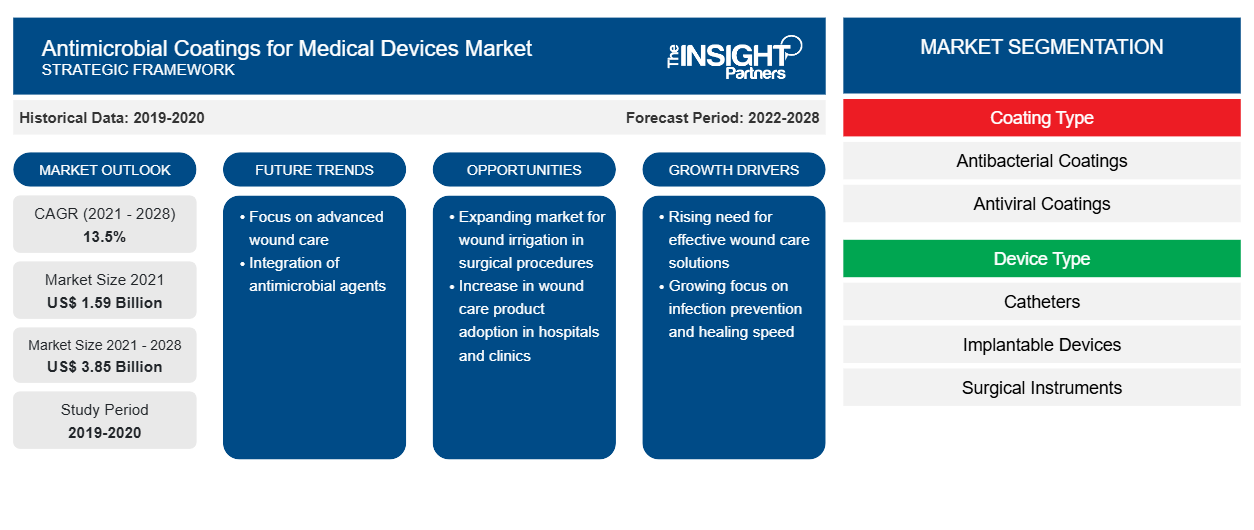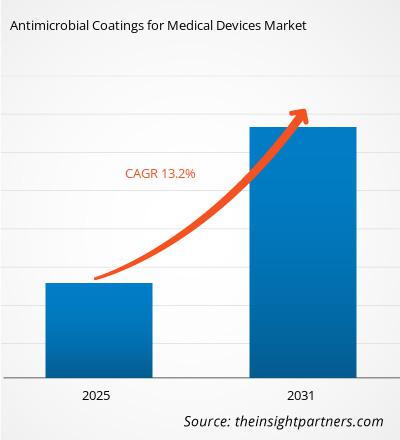The antimicrobial coatings for medical devices market size is projected to reach US$ 6.49 billion by 2031 from US$ 2.80 billion in 2024. The market is expected to register a CAGR of 13.2% during 2025–2031. Nanotechnology integration is likely to remain a key trend in the antimicrobial coatings for medical devices market.
Antimicrobial Coatings for Medical Devices Market Analysis
The antimicrobial coatings for medical devices market is anticipated to witness substantial growth in the coming years due to the rising prevalence of healthcare-associated infections (HAIs), rising demand for advanced medical technologies, and growing focus on patient safety. Key players in the market are investing in research and development to develop innovative antimicrobial coatings with enhanced efficacy and durability. Geographically, North America and Europe are expected to dominate the market due to the presence of a well-established healthcare infrastructure and stringent regulations regarding the use of antimicrobial coatings in medical devices.
Antimicrobial Coatings for Medical Devices Market Overview
Antimicrobial coatings are applied to medical devices such as catheters, implants, and surgical instruments to inhibit the growth of harmful microorganisms and reduce the risk of infections. These coatings can be made from various materials, including silver, copper, and quaternary ammonium compounds, each of which has intrinsic unique properties and effectiveness. The market progress is driven by factors such as the increasing awareness of the importance of infection control, the surging adoption of minimally invasive procedures, and the growing demand for advanced medical devices that can prevent the spread of infectious diseases. In France, the government extends high economic support toward research related to antimicrobial coatings. For instance, in February 2022, SPARTHA Medical, a French MedTech company providing multifunctional antimicrobial, antiviral, and anti-inflammatory coatings, received €2.4 million (US$ 2.75 million) in grants, along with additional undisclosed equity financing from the European Innovation Council (EIC) Fund. In addition, in December 2021, SPARTHA Medical announced the completion of its finalized first round of funding of €1.4 million (US$ 1.44 million) to develop customized coatings. Notably, French medical device manufacturers are acknowledged for their potential contribution to the success of handling the COVID-19 pandemic effectively and maintaining its import and export ratio during the financial crisis. Similarly, Germany boasts a robust healthcare system that manages the treatment of thousands of patients daily. The German commission also emphasizes the importance of hospital hygiene and infection control, providing valuable recommendations that favor the development and adoption of effective antimicrobial coatings.
Customize This Report To Suit Your Requirement
You will get customization on any report - free of charge - including parts of this report, or country-level analysis, Excel Data pack, as well as avail great offers and discounts for start-ups & universities
Antimicrobial Coatings for Medical Devices Market: Strategic Insights

- Get Top Key Market Trends of this report.This FREE sample will include data analysis, ranging from market trends to estimates and forecasts.
You will get customization on any report - free of charge - including parts of this report, or country-level analysis, Excel Data pack, as well as avail great offers and discounts for start-ups & universities
Antimicrobial Coatings for Medical Devices Market: Strategic Insights

- Get Top Key Market Trends of this report.This FREE sample will include data analysis, ranging from market trends to estimates and forecasts.
Antimicrobial Coatings for Medical Devices Market Drivers and Opportunities
Rising Prevalence of Hospital-Acquired Infections Bolsters Market Growth
Hospital-acquired/healthcare-associated infections (HAIs) encompass catheter-associated urinary tract infections (CAUTI), central line-associated bloodstream infections, and ventilator-associated pneumonia. These infections can also arise at surgical sites, known as surgical site infections (SSIs). HAIs impose a significant economic burden on the healthcare system. According to the US Department of Health and Human Services, the increasing prevalence of HAIs (which affect nearly 1 in 31 hospitalized patients) and the growing emphasis on infection control drive the demand for advanced antibacterial solutions. Further, the Centers for Disease Control and Prevention (CDC) lists CAUTIs among the most common HAIs. CAUTIs are linked to increased morbidity, mortality, healthcare costs, and longer hospital stays. As per the CDC, 15–25% of hospitalized patients receive urinary catheters during their stay, which are associated with approximately 75% of UTIs acquired in hospitals. The use of antibacterial coatings on catheters can help reduce the incidence of these infections by inhibiting bacterial colonization. The burgeoning awareness of infection control, a rise in the number of surgical procedures, and the growing prevalence of chronic diseases that often require catheterization in patients bolster the antibacterial coatings for medical devices market growth.
Funding Initiatives by Public and Private Organizations to Create Growth Opportunities
In February 2022, Spartha Medical received a grant of US$ 2.75 million from the European Innovation Council. The company had plans to use these funds to advance its antimicrobial, antiviral, and anti-inflammatory coatings; launch clinical trials; build its infrastructure and team; and further develop its coating technology. Earlier in 2020, a research project titled "Antibacterial Layer-by-Layer Coatings for Medical Implants” was published by researchers at the Center for Cooperative Research in Biomaterials (CIC biomaGUNE, Spain). The study revealed the efficiency of the layer-by-layer technique that offers multiple possibilities for the application of antibacterial coatings on implants. The MAT2017-88752-R Retos project from the Spanish Ministry of Economics funded the research. Such funds made available by public and private organizations provide support to the R&D and clinical studies related to antimicrobial coating, which is likely to benefit the antimicrobial coatings for medical devices market in the coming years. The rise in funding and investments also creates opportunities for new entrants and emerging market players.
Antimicrobial Coatings for Medical Devices Market Report Segmentation Analysis
Key segments that are the foundation of antimicrobial coatings for medical devices market analysis are material, coating type, device type, application, and end user.
- Based on material, the antimicrobial coatings for medical devices market is categorized into metallic coatings and non-metallic coatings. The metallic coatings segment held a larger share of the market in 2024.
- By coating type, the market is segmented into antibacterial coatings, antiviral coatings, and others. The antibacterial coatings segment held the largest antimicrobial coatings for medical devices market share in 2024.
- In terms of device type, the antimicrobial coatings for medical devices market is segmented into catheters, implantable devices, surgical instruments, and others. The implantable devices segment dominated the market in 2024.
- Based on application, the antimicrobial coatings for medical devices market is segmented into general surgery, cardiovascular, orthopedics, gynecology, dentistry, and others. The cardiovascular segment held the largest share of the market in 2024.
- By end user, the market is categorized into medical device manufacturers, contract manufacturers, and service providers. The medical device manufacturers segment held the largest antimicrobial coatings for medical devices market share in 2024.
Antimicrobial Coatings for Medical Devices Market Share Analysis by Geography
The geographic scope of the antimicrobial coatings for medical devices market report is divided into five regions: North America, Asia Pacific, Europe, Middle East & Africa, and South & Central America.
North America held a significant share of the market in 2024. The rising prevalence of HAIs underlines the need for developing medical devices with antimicrobial coatings in this region. HAIs may occur in all types of healthcare settings, including ambulatory surgical centers, dialysis facilities, acute care hospitals, outpatient care (e.g., physicians' offices and healthcare clinics), and long-term care facilities (e.g., nursing homes and rehabilitation facilities). As per the US Department of Health and Human Services, 1 out of every 25 hospitalized patients are affected by HAI at any time in the US. In American hospitals alone, the CDC projected that HAIs account for an estimated 1.7 million infections and 99,000 associated deaths annually, which indicates growth prospects for the antimicrobial coatings for medical devices market.
Antimicrobial Coatings for Medical Devices Market Regional Insights
The regional trends and factors influencing the Antimicrobial Coatings for Medical Devices Market throughout the forecast period have been thoroughly explained by the analysts at The Insight Partners. This section also discusses Antimicrobial Coatings for Medical Devices Market segments and geography across North America, Europe, Asia Pacific, Middle East and Africa, and South and Central America.
Antimicrobial Coatings for Medical Devices Market Report Scope
| Report Attribute | Details |
|---|---|
| Market size in 2024 | US$ 2.80 Billion |
| Market Size by 2031 | US$ 6.49 Billion |
| Global CAGR (2025 - 2031) | 13.2% |
| Historical Data | 2021-2023 |
| Forecast period | 2025-2031 |
| Segments Covered |
By Material
|
| Regions and Countries Covered | North America
|
| Market leaders and key company profiles |
|
Antimicrobial Coatings for Medical Devices Market Players Density: Understanding Its Impact on Business Dynamics
The Antimicrobial Coatings for Medical Devices Market is growing rapidly, driven by increasing end-user demand due to factors such as evolving consumer preferences, technological advancements, and greater awareness of the product's benefits. As demand rises, businesses are expanding their offerings, innovating to meet consumer needs, and capitalizing on emerging trends, which further fuels market growth.

- Get the Antimicrobial Coatings for Medical Devices Market top key players overview
Antimicrobial Coatings for Medical Devices Market News and Recent Developments
The antimicrobial coatings for medical devices market is evaluated by gathering qualitative and quantitative data post primary and secondary research, which includes important corporate publications, association data, and databases. A few of the developments in the market are listed below:
- Hydromer, Inc., a manufacturer of hydrophilic, thromboresistant, and antimicrobial coating technologies for medical devices, launched HydroThrombX, a next-generation version of the company's current legacy product F200t. F200t is a thromboresistant coating well-known for significantly reducing platelet adhesion and cell mitosis, aiding in the prevention of restenosis. (Source: Hydromer, Inc., Press Release, June 2024)
- Biointeraction announced the launch of its TriDant antimicrobial coating. TridAnt includes active and passive components. According to BioInteractions, the new product is a non-leaching coating that provides infection resistance to the surface and reduces the risk of biofilm formation, all without any toxic or eluting components. The coating targets a broad spectrum of bacteria, significantly reducing the infection risk. BioInteractions is marketing TridAnt for use on venous and urinal catheters, contact lenses, titanium cranioplasty, wound dressings, labels, and protective paint for ships. (Source: BioInteractions Ltd, Press Release, April 2022)
Antimicrobial Coatings for Medical Devices Market Report Coverage and Deliverables
The "Antimicrobial Coatings for Medical Devices Market Size and Forecast (2021–2031)" report provides a detailed analysis of the market covering below areas:
- Antimicrobial coatings for medical devices market size and forecast at global, regional, and country levels for all the key market segments covered under the scope
- Antimicrobial coatings for medical devices market trends and market dynamics such as drivers, restraints, and key opportunities
- Detailed PEST and SWOT analysis
- Antimicrobial coatings for medical devices market analysis covering key market trends, global and regional framework, major players, regulations, and recent market developments
- Industry landscape and competition analysis covering market concentration, heat map analysis, prominent players, and recent developments in the antimicrobial coatings for medical devices market
- Detailed company profiles
Frequently Asked Questions
What are the factors driving antimicrobial coatings for medical devices market growth?
Which region dominated the antimicrobial coatings for medical devices market in 2024?
What is the expected CAGR of the antimicrobial coatings for medical devices market?
Which are the leading players operating in the antimicrobial coatings for medical devices market?
What would be the estimated value of the antimicrobial coatings for medical devices market by 2031?
- Historical Analysis (2 Years), Base Year, Forecast (7 Years) with CAGR
- PEST and SWOT Analysis
- Market Size Value / Volume - Global, Regional, Country
- Industry and Competitive Landscape
- Excel Dataset
Recent Reports
Related Reports
Testimonials
Reason to Buy
- Informed Decision-Making
- Understanding Market Dynamics
- Competitive Analysis
- Identifying Emerging Markets
- Customer Insights
- Market Forecasts
- Risk Mitigation
- Boosting Operational Efficiency
- Strategic Planning
- Investment Justification
- Tracking Industry Innovations
- Aligning with Regulatory Trends





















 Get Free Sample For
Get Free Sample For